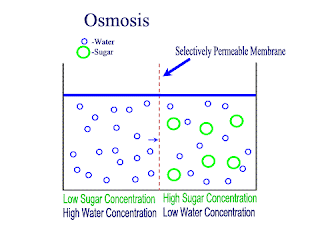 1- Parenchyma
1- Parenchyma - living cells
- round in shape
- thin cell walls
- large vacuole
- functional cell e.g; Chlorenchyma cell--> mesophyll cells
- large intercellular spaces
 2- Collenchyma
2- Collenchyma- living cells
- rectangular in shape
- thick cell walls
- smaller vacuoles
- can be functional + supportive
- no intercellular spaces
- in bends of plant
 3- Sclerenchyma
3- Sclerenchyma- dead cell
- present as long fibres
- very thick cell walls
- no intercellular spaces
- non-functional but supportive
- scattered specially around vesicular bundles
Transport of water: from soil to plant
Soil has higher water potential gradient as compared to root hair cells, water molecules enter root hair cells by osmosis down the concentration gradient
Root hair cells has a long extension which increase surface area for better absorption it has thin cell walls and a lot of mitochondrea
Q) What are the different pathway for transfer of water molecules across cortex cells?
1- Symplast pathway:
osmosis as water molecules pass through cell membrane and cytoplasm, and are then taken up to the next cell down the water potential gradient
2- Vacular pathway:
kind of symplast pathway when water passing through cytoplasm also enters the vacuole
3- Apoplast pathway:
In which water doesn't enter the cytoplasm but diffuses across the cellulose cell wall due to adhesion and cohesion
(Sucrose actively loaded into sieve tube elements decreases the water potential causing the hydrostatic pressure to increase)
Translocation:
 - transport of assimilates from source to sink (through phloem vessels)
- transport of assimilates from source to sink (through phloem vessels)- sucrose and amino acids assimilates exose
- Source: part of plant where assimilates are loaded up into the vessels e.g; photosynthesising leaves or storage organs (green leaves)
- Sink: part of plant where unloading takes place e.g; growing part of plant (storage roots)
Structure of Phloem~
* made from specialized cells called sieve elements which have cytoplasm, Organelles are absent
* they have sieve pores in the cross walls which results in formation of sieve plates
* they are accompanied by companion cells adjacent to them
* they are lots of plasmodesmata between sieve elements and companion cells
* companion cells are true cells with usual cytoplasm, a small vacuole and many mitochondrea since they perform active transport
(water movement from roots to leaves: evaporation of water from the messophyll cell walls)
Loading of Assimilates:
mesophyll cells photosynthesize to form glucose which can be stored as starch. rest of it becomes sucrose which is to be loaded into the sieve element
+ the adjacent companion cell with use of ATP pumps hydrogen ions into mesophyll cells by active transport
+ these hydrogen ions being in higher assimilation move back into companion cells through a co-transport prokin along with sucrose molecule against concentration gradient
+ this lowers the solute potential and water potential in companion cell
+ water enters companion cell from surrounding cells by osmosis
+ this increases the hydrostatic pressure and causes the sucrose solution to diffuse into sieve element
Passage of assimilates through sieve elements~
- hydrostatic pressure that develops in a sieve element (the source) because of osmosis decides for direction of movement as it goes down the pressure gradient, from higher pressure to lower pressure. this results in translocation from source to sink
Unloading of Assimilates:
In sink the sieve element having higher concentration of sucrose than the adjacent cells, results in diffusion of sucrose and amino acids down the concentration gradient
+ concentration in always kept lower due to enzyme invertase which converts sucrose into glucose and fructose
Transpiration~
 evaporation of water molecules from cell walls of mesophyll cells which then escapes through stomata.
evaporation of water molecules from cell walls of mesophyll cells which then escapes through stomata.Stomata: loss of water vapour from leaves
stomata are open for gas exchange
stomata opens as light intensity increases
Factors of transpiration:
1- temperature increases, transpiration increases
2- wind increases, transpiration increases
3- humidity increases, transpiration decreases
4- light intensity increases, transpiration increases
*Protometer is used to measure transpiration rate*
Xerophytes:
- desert
- hot climate
- lesser water supply
1) waxy cuticle
2) sunken stomata
3) trichomes (hair)
4) surface area decreases
5) fleshy green
6) very deep and wide spread
7) less frequent stomata per unit area

Hydrophytes:
- stomata on uper epidermis
- are spaces (large)
Mesophytes:
- normal (leaves) plants











































